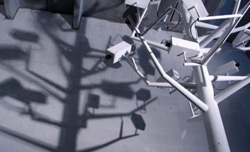

 Alexandrea Arrechea’s Garden of Mistrust may be the ultimate functional metaphor for the peculiar fusion of electronic surveillance and social isolation which has become a hallmark of our troubled times. A writhing, intrusive, mock-entity, Garden of Mistrust has all the presence and aggression of a misbehaving toddler, yet its motivations are considerably less simple. On the one hand, the work enables a viewer to participate in the dissemination of one’s own image and/or activity as part of an ongoing ‘performance,’ while simultaneously witnessing the experiences of others who may not currently share your time-space coordinates, along with more who do. Ultimately, the Garden’s purpose is not to lull us into ever-deeper moral complacency, but alert us to the extent to which the image of own surveillance has been transformed into an essential currency of our daily lives.
Alexandrea Arrechea’s Garden of Mistrust may be the ultimate functional metaphor for the peculiar fusion of electronic surveillance and social isolation which has become a hallmark of our troubled times. A writhing, intrusive, mock-entity, Garden of Mistrust has all the presence and aggression of a misbehaving toddler, yet its motivations are considerably less simple. On the one hand, the work enables a viewer to participate in the dissemination of one’s own image and/or activity as part of an ongoing ‘performance,’ while simultaneously witnessing the experiences of others who may not currently share your time-space coordinates, along with more who do. Ultimately, the Garden’s purpose is not to lull us into ever-deeper moral complacency, but alert us to the extent to which the image of own surveillance has been transformed into an essential currency of our daily lives.
Arrechea brings to his art a deep fascination with symbols that reverberate on multiple levels, and Garden of Mistrust is above all else a form of socio-cultural icon for an age in which there are few if any limits on the ways that both voyeurism and narcissism can be exercised. Our culture is now a borderless nest of non-stop spying -- from web-cams installed in individuals’ bedrooms, which transmit the most private acts to an audience scattered around the world, to city streets lined with hidden cameras that can record for posterity a crime unfolding in a dark alley. Whereas throughout history a daring few labored mightily in order that their achievements be noticed by others, today people’s entire lives are lived out under the assumption that many of their activities are being registered and even recorded without their being aware of it. Being watched is just another way of being noticed.
It is no accident that Arrechea has labeled his installation a garden, since its social function appears to be similar to the framing of nature as a temporary respite from the stress and pollution of an industrialized society. With this Garden of Mistrust, however, one does not flee the burdens of an all-surveillance society so much as plunge oneself into its midst, succumbing to the hypnotic reassurances of the electronic eye as a form of talisman, which in turn represents the surrender of one’s ego in the light of a larger and more pervasive truth. In that sense, Garden of Mistrust suggests that today relief comes in the form of pulling away the veil of concealment from the immense surveillance apparatus which is already in place -- an unmasking of the not-so-benevolent motives that compel us to watch each other relentlessly, and to hide ourselves in the act of doing so.